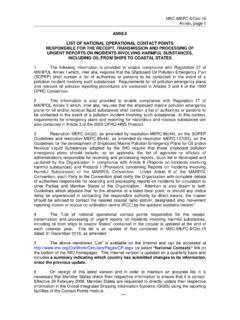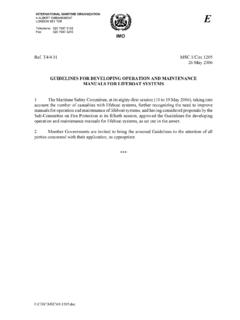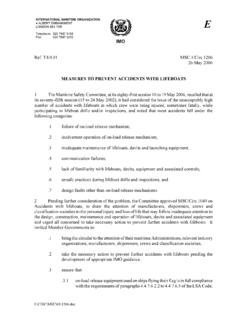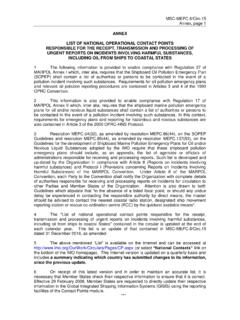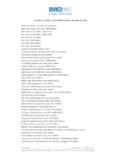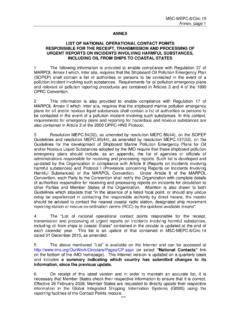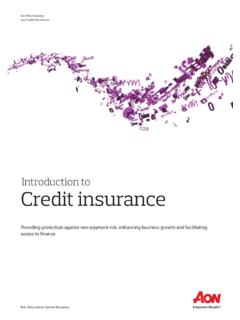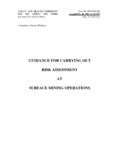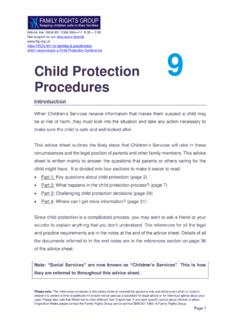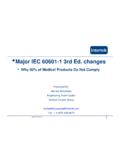Transcription of Guidelines for Owners, Operators and Masters for ...
1 1 Guidelines for Owners, Operators and Masters for protection against Piracy in the Gulf of Guinea Region (To be read in conjunction with BMP4) 1. Introduction Piracy and armed robbery (hereafter referred to as piracy) in the Gulf of Guinea region is an established criminal activity and is of increasing concern to the maritime sector. With attacks becoming more widespread and violent, including the increase in kidnapping for ransom, industry has now identified an urgent need to update these Guidelines . They also now take into account the regionally established Maritime Trade Information Centre (MTISC). Although piracy in the Gulf of Guinea region in many ways differs from that of Somalia-based piracy, large sections of the Best Management Practices already developed by industry to help protect against Somalia-based piracy are also valid in the Gulf of Guinea region.
2 Consequently, these Guidelines aim to bridge the gap between the advice currently found in BMP4 and the prevailing situation in the Gulf of Guinea region. These Guidelines should therefore be read in conjunction with BMP4 and will make reference to BMP4 where relevant. The Guidelines have been developed by BIMCO, ICS, INTERCARGO and INTERTANKO and are supported by NATO Shipping Centre. A soft copy of BMP4 can be found on the websites of these organisations. 2. Area for consideration Pirates in the Gulf of Guinea are flexible in their operations so it is difficult to predict a precise area where a ship might fall victim to piracy. For the purpose of this guidance the area off the coasts of Ghana, Nigeria, Togo, Cameroon and Benin can be regarded as an area in which the counter-piracy management practices should be considered.
3 Attacks and armed robbery have occurred from as far south as Angola and north as Sierra Leone. In addition, as of 12 June 2014, the LMA Joint War Committee defines the following Listed Areas for Hull War, Piracy, Terrorism and Related Perils for the Gulf of Guinea: The territorial waters of Benin, Togo and Nigeria, plus Nigerian Exclusive Economic Zone north of latitude 3 N, plus Beninese Exclusive Economic Zones north of latitude 3 N. Togolese Exclusive Economic Zone north of latitude 3 N. The LMA Joint War Committee listed areas should be checked regularly for changes. 2 3. Risk Assessment For the purpose of identifying suitable measures of prevention, mitigation and recovery in case of piracy, a ship and voyage-specific risk assessment as recommended in Section 3 of BMP4 should be carried out prior to entering the area described in Section 2 above.
4 Not unlike the Ship Security Assessment described in the ISPS Code, the risk assessment should include, but may not be limited to, the following: The threat (who are the pirates, what do they want to achieve, how do they attack, how do they board, which weapons do they use ) Background factors shaping the situation (visibility, sea-state, traffic patterns other commercial ships, fishermen and human traffickers etc.) Possibilities for co-operation with military (escorting, employment of Vessel protection Detachments, registering with authorities etc.) The ship s characteristics/vulnerabilities/inherent capabilities to withstand the threat (freeboard, speed, general arrangement etc.)
5 Ship s procedures (drills, watch rosters, chain of command, decision making processes etc.) In addition to the information found in this document, supplementary information about the characteristics of the threat and regional background factors may be sought from, regional reporting centres, Shipping Association websites, the IMB, commercial intelligence providers or local sources ships' agents as in the attached Annex. As also mentioned in BMP4, the risk assessment should take into consideration any statutory requirements, in particular those of the flag state and/or the coastal state. Other requirements dictated by company and insurance policies should also be taken into consideration.
6 3 The risk assessment process Much of this risk assessment already exists in BMP4, since it provides an overall list of which actions to take to defend against pirate attack. However, the guidance in BMP4 must be developed into specific actions to take and self-defence measures to apply on a ship-by-ship and voyage-by-voyage basis. For example, many pirate attacks in the Gulf of Guinea region occur whilst ships are at anchor or drifting, in which case BMP4 self-defence measures like "evasive manoeuvring" are not readily applicable. Thus, the risk assessment must reflect the prevailing characteristics of the specific voyage and ship, and not just be a repetition of advice relating to a different geographical region and a different pirate modus operandi.
7 Detailed guidance on preparing risk assessments can be found from a variety of sources including the ISPS code, which for example forms the base line for the BIMCO Ship and Voyage Specific Risk Assessment (SVSRA). 4 4. Typical Pirate Attacks Currently, the Gulf of Guinea "pirate business model" is primarily aimed at theft and kidnapping for Generally speaking, pirates in the Gulf of Guinea are more violent than their Somalia based colleagues. Pirate activity within the Gulf of Guinea can be split broadly into the following categories: Armed Robbery In general this is opportunistic, is violent, and occurs where vessels are approaching, drifting or anchored off ports.
8 There have been instances across the Gulf of Guinea Region off Lagos, in Port Harcourt, Bonny River, Cotonou and Lome. For the most part the intention is to take valuables from the safe, IT equipment, and personal effects. Cargo theft This occurs throughout the area described and often occurs in or about the STS transfer areas where ships are particularly vulnerable. In the main it is related to product and chemical tankers but there are also regular attacks and thefts on general cargo carriers . Vessels are hijacked for several days and cargo is transferred to a smaller vessel. These incidents are well-organised, often involving a criminal element with commercial interests ashore.
9 Recent cargo thefts have demonstrated that pirates often have a maritime know-how allowing them to disable communications, operate the cargo system, etc. Kidnapping All seafarers are at risk. There have been several instances of offshore supply vessels and tankers being attacked and seafarers taken ashore for ransom. Methodology: Pirate attacks in the Gulf of Guinea region often share similar characteristics to those of Somalia based pirates (see BMP 4 Section 4), but there are some key differences. For example, The main threat is from approaches made by high-powered speedboats, and a recent incident involved a speedboat launched from an unidentified mothership.
10 The risk of falling victim to a pirate attack is particularly high when the ship is at anchor or is drifting off a port close to pilot station. Another vulnerable situation is when conducting STS operations and the two ships are adrift and moored alongside each other. For the tanker sector, cargo theft results in stolen oil products being sold in the region. For the dry cargo and other sectors, violent robbery is more common. Attacks, both outside and inside territorial waters, appear to be the result of intelligence-led planning by the pirates, with particular products such as gasoil or gasoline being targeted in very well co-ordinated and executed operations.
